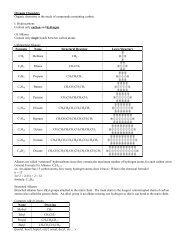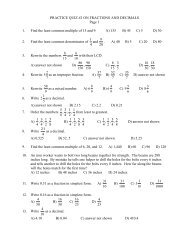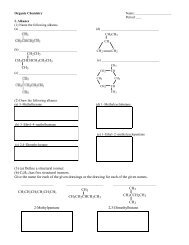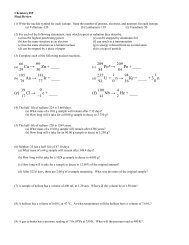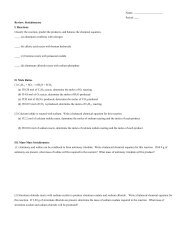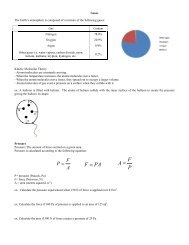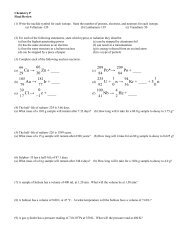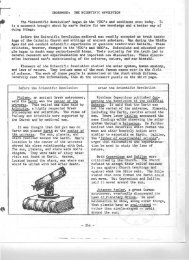- Foreign policy during this period was placed in the capable hands of John Quincy Adams, who served asSecretary of State (1817 – 1825) and was a skillful diplomat and negotiator. JQ was an expansionist whopushed to obtain fishing rights for the US in the Atlantic, political separation from Europe, and peace.- Important post-war treaties under JQ include… Rush-Bagot Treaty (1817) – agreement between the US and GB to limit their naval forces inthe Great Lakes. It was the first modern disarmament treaty and led to the eventualdemilitarization of the US-Canada border. Then, at the Convention of 1818 the US-Canadaborder was fixed at the 49th parallel.Adams-Onis Treaty (1819) – agreement between US and Spain that <strong>com</strong>pleted the USacquisition of Florida [Northern border came from the Pinckney treaty, Western border in 1810,and the Northeast was invaded by Jackson in 1818, which precipitated the Seminole Wars].- Only one danger zone remained for the US after the treaties, and that was Latin <strong>Am</strong>erica. In 1822, the USbecame the first non-Latin <strong>Am</strong>erican nation to recognize the newly formed countries – but JQ was quick torealize that France would soon try to return the region to colonial rule.- GB also caught this and proposed a joint US-British statement against European intervention in the area,but JQ refused, insisting the US had to act independently.- In December 1823 the Monroe Doctrine was introduced to Congress. It basically called for: no moreEuropean colonization of the Western Hemisphere or European intervention in independent <strong>Am</strong>ericannations. In return the US wouldn’t interfere in Europe.- Essentially, the MD was a big bluff b/c the US didn’t have the military strength to enforce it. Luckily, theBritish had their own motives for keeping the rest of Europe away [trade], so it worked out.*Economic Growth after the War of 1812*- After the War of 1812 <strong>Am</strong>ericans became increasingly involved in the market economy, and jobs becamemore specialized as transportation improved.- As farmers and craftsmen formerly had only to cater to the needs of their small <strong>com</strong>munities, wherebartering allowed them to get goods they couldn’t produce themselves, with the spread of canals andrailroads, they began producing crops and goods for cash sale in nat’l and internat’l markets.- The division of labor, <strong>com</strong>bined with increasing mechanization, new financial methods and transportationcaused tremendous expansion in the economy, which prompted more improvements, and so on.- Growth, however, was uneven: there was great prosperity from 1823 – 1835 and from 1839 – 1843, but inbetween there were periods of deflation [dec. in prices] where banks collapsed and many businesses failed.These cycles were known as boom-and-bust cycles.- The first crash occurred in Panic of 1819 – avid speculation on Western lands had led to a precarioussituation, and when manufacturing fell in 1818, prices fell drastically. This devastated workers.- What caused the boom-and-bust cycles? Direct result of the market economy b/c prosperity first stimulateddemand for manufactured goods, leading to higher prices, higher production, and speculation in land. Whenproduction surpassed demand, prices and wages fell, causing land and stock values to collapse.- Most felt that the B&B cycles were a way of weeding out unprofitable businesses, making the economymore efficient. And, at least in theory, each seller determined the price – so the market economy increasedindividual freedom.*The Government’s Role in the Market Economy*- Most believers in the market economy felt that limited government participation allowed for the mosteconomic expansion.- Nevertheless, the government actually had an active role in economic growth through… United State Post Office – helped spread information and set up first telegraph lines Patent laws – protected inventors Protective tariffs – encouraged domestic manufacturing Surveying new land – allowed farmers to settle further West and use new lands Improving transportation – linked <strong>com</strong>merce, esp. linking Western farmers to the East- The judiciary encouraged gov’t involvement in the economy and business in general. See Gibbons v.Ogden (1824), which broadly defined Congress’ power over interstate <strong>com</strong>merce and Dartmouth College v.Woodward (1819), which protected contracts against state interference.- The concept of the corporation also emerged through federal and state court rulings: corporations, groupsallowed to hold property and do business as if they were individuals, were allowed to sell shares where theshareholders were granted limited liability [no responsibility in <strong>com</strong>pany’s debt beyond original investment].- This encouraged people to support new businesses, and the number of corporations grew. Early on speciallegislative acts were needed for each corporation, but after the 1830s procedures were est. to make theprocess faster.26
- Court rulings extended the powers of corporations, as in the Charles River Bridge v. Warren Bridge (1837)case, in which it was decided that new enterprises couldn’t be held back by implied privileges under oldcharters – encouraging <strong>com</strong>petition and new industries.- State gov’ts played a very large role in promoting the economy: they invested in railroads starting in the1830s, provided banks and corporations w/capital, and regulated the activities of corporations and banks.- As a result of gov’t efforts the US economy grew [unevenly] from 1812 to around 1850. As the economygrew, though, the dependence of the corporations on the states for investments declined.*Improvements in Transportation*- Following the War of 1812 the states invested in roads, canals and railroads. This increased theimportance of the northeastern seaboard cities, which were already financial centers, by centralizing exportsfrom the South and West there. By contrast, the South spent little $ on transportation and stayed rural.- Water routes were the primary modes of transportation, but as settlement moved beyond the major riversnew methods of transportation were developed: National Road – this highway began in Maryland and reached Ohio in 1833. Erie Canal – <strong>com</strong>pleted in 1825, the canal linked the Great Lakes with NYC and set off a waveof canal building across the country. Railroads – as investment in canals fell in the 1830s, railroad construction boomed [but it wasnot until the 1850s that long-distance service was offered at good rates].- New technology reduced travel time and shipping greatly, stimulating the economy.*Sectors of the Market Economy: Commercial Farming*- Agriculture still remained the backbone of the economy in the market economy era – it just changed fromself-sufficient household units producing enough for their sustenance to larger, market-oriented ventures.- Each areas of the country began to specialize its production, as follows: New England – due to a lack of space and bad terrain, <strong>com</strong>mercial crop farming becameincreasingly impractical in NE beginning in the 1820s. Instead, NE families improved theirlivestock, specialized in dairy/vegetable/fruit production [financed through land sales, whichreally was the greatest source of profit], moved west, or gave up on farming altogether. Old Northwest/Western Territories – this region took over the <strong>com</strong>mercial crop farming fromNE. Large, flat farms were formed, and the mechanization of agriculture helped enormously. In1831 Cyrus McCormick invented the reaper, which he patented in 1834 and began making ina factory, and in 1837 John Deere invented the steel plow.South – after 1800, the South shifted from a more diverse agriculture to one based almostentirely on cotton. This was due to Eli Whitney’s invention of the cotton gin in 1793, whichseparated short-staple [the easy to grow kind] cotton from its seeds efficiently. Although theSouth was in internat’l markets, it remained a rural society, w/most of the wealth in land andslaves, and couldn’t shift to manufacturing or <strong>com</strong>merce [business decisions made in North].- Overall, specialization benefited many, but also made it more difficult for farmers to start up [high landprices] and therefore increased the # of tenant farmers.*Sectors of the Market Economy: The Rise of Manufacturing and Commerce*- <strong>Am</strong>erican production began with copies of British or other European designs, but before long <strong>Am</strong>ericanswere creating their own machines [ex. Matthew Baldwin, steam lo<strong>com</strong>otives, by 1840 exported internat’lly].- The <strong>Am</strong>erican System of Manufacturing was created, which involved using precision machinery to produceinterchangeable parts that didn’t require adjustment to fit. Eli Whitney promoted the system in 1798w/respect to rifles, and by the 1820s the US had contracts w/firms to produce machine made firearms. Thesystem soon spread to mainstream manufactures, leading to an outpouring of consumer goods.- But the biggest industry was without a doubt textiles, which had been helped by the embargo, war, and theexpansion of cotton cultivation. The big innovation was machine-spun textiles in mills, a system thatespecially took hold in NE [Lowell, Massachusetts].- Mass produced textiles led to the ready-made clothing industry [by 1820s/1830s most clothing was massproduced], either via factories or by the putting-out system, and retail clothing stores appeared in the 1820s.- The expansion of manufacturing directly encouraged a rise in <strong>com</strong>merce – agents began to specialize infinance alone [cotton brokers, corn brokers, etc.] and general merchants declined, remaining more in ruralareas than in cities.- Esp. in large northeastern <strong>com</strong>mercial cities, merchants engaged in <strong>com</strong>plex transactions – leading to boththe rise of the office as we know it and the expansion of financial institutions.27
- Page 3 and 4: Congregationalists (Puritans) - The
- Page 5 and 6: - So the Restoration Colonies, form
- Page 7 and 8: - So in England, where they were lo
- Page 9 and 10: *Colonial Politics 1700-1750: Relat
- Page 11 and 12: - Another ideology that was beginni
- Page 13 and 14: - The Quebec Acts were passed aroun
- Page 15 and 16: - So, by 1782, what had seemed to b
- Page 17 and 18: on the economic side, since the gov
- Page 19 and 20: - Anyway, Congress had several ques
- Page 21 and 22: - Adams was still in the early Wash
- Page 23 and 24: *Political Factionalism and Jeffers
- Page 25: - Samuel Slater set up the first te
- Page 29 and 30: Revival, Reform and Politics during
- Page 31 and 32: - Anyhow, during his administration
- Page 33 and 34: TEXAS (Southerners) - Texas had bee
- Page 35 and 36: - Anyhow, Pierce’s total support
- Page 37 and 38: They had a smaller everything: smal
- Page 39 and 40: - The two Northern victories at the
- Page 41 and 42: - The result was the Fourteenth Ame
- Page 43 and 44: The Slaughter-House Cases (1873) -
- Page 45 and 46: in the arrest of 8 immigrant radica
- Page 47 and 48: case (1897 - ICC can’t set rates)
- Page 49 and 50: - The Populists prepared to run aga
- Page 51 and 52: - MOST IMPORTANTLY, though, was the
- Page 53 and 54: - So, what led the US to undertake
- Page 55 and 56: - The rebellion, led by Emilio Agui
- Page 57 and 58: - Still, Americans managed to turn
- Page 59 and 60: - So - the point of this episode? B
- Page 62 and 63: *Hoover’s Response*- Poor Herbert
- Page 64 and 65: - In FDR’s second term, however,
- Page 66 and 67: Dominican Republic - When we left i
- Page 68 and 69: World War II (1941 - 1945)*The Cour
- Page 70 and 71: - So Truman started off again all c
- Page 72 and 73: - First of all, the 1950s were (for
- Page 74 and 75: peace w/Japan that ended occupation
- Page 76:
- France wanted out, so at the Gene



